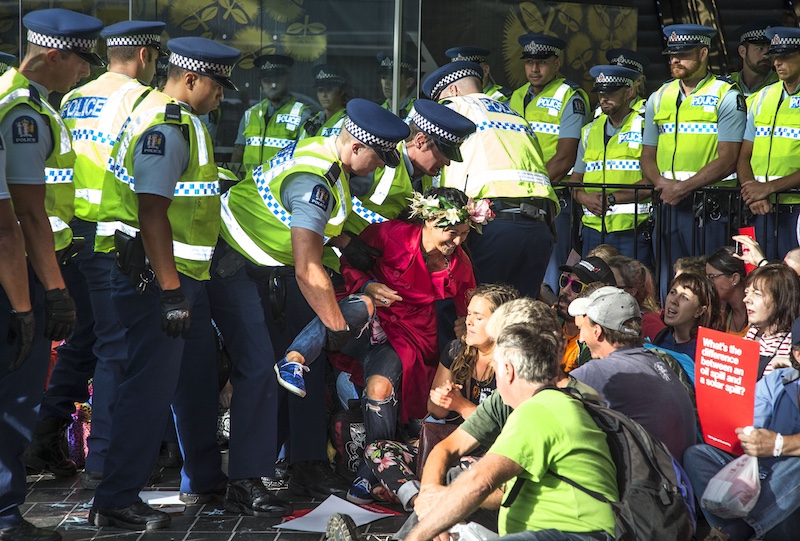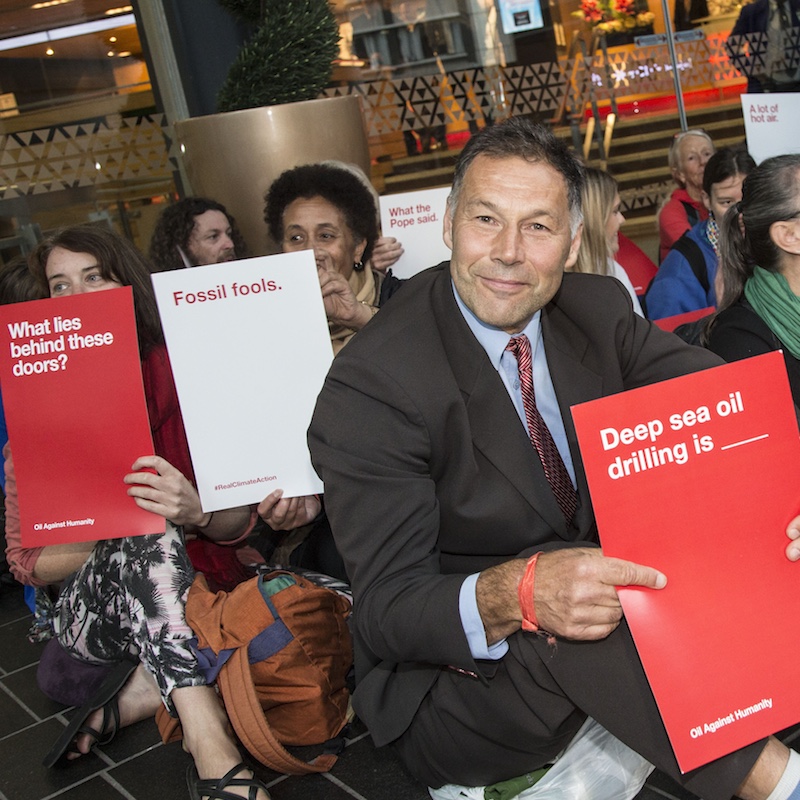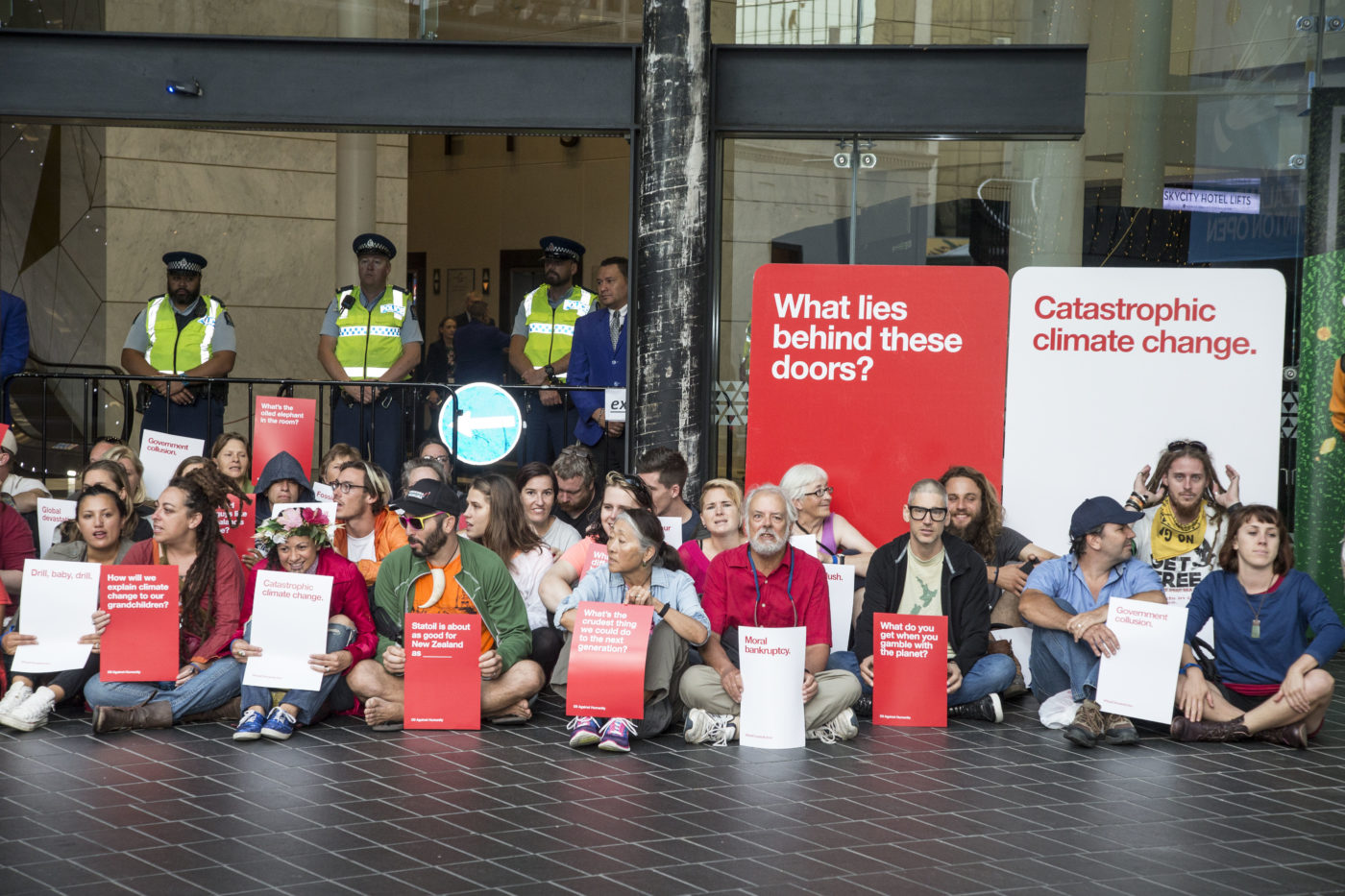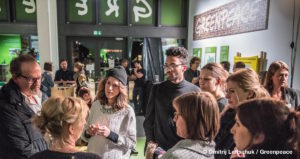In March 2016, Greenpeace New Zealand (GPNZ) called on members of the public to blockade the annual New Zealand Petroleum Conference in Auckland. The action marked one of the first times a Greenpeace office invited the general public to directly participate in non-violent direct action (NVDA).
Many did not have a prior relationship with Greenpeace nor any NVDA experience. Some organisers had participated in a prior open action coordinated by a coalition of activists and groups (read more about that here) but this action was Greenpeace New Zealand’s first attempt at running a public NVDA.
By opening up the action, GPNZ sought to enable and empower as broad a spectrum of society as possible. The organisation also tested new climate campaign tactics, particularly involving open campaigning.
Over 200 people participated in a dignified and peaceful manner and significant disruption was caused to the conference. Many participants had never taken direct action before and came away reporting feeling energised and empowered. Some went on to participate in other climate actions like those organised by 350.org.
Opening up a direct action proved to be an important step forward. Many on the project team operated outside their comfort zone and reported learning important lessons. I recently spoke to several members of the team to understand what they picked up from the experience.
Don’t underestimate the time needed to navigate new ways of working
The logistics of the action seemed simple – a blockade of a building that GPNZ staff knew well from previous events. But announcing the event four weeks in advance and inviting the public to join in gave the team much more to work through. The risk assessment needed to cover more ground than usual and took longer than expected. For example, all of the public communications ahead of the event had to be thoroughly checked over.

More than 200 people descended on New Zealand’s largest oil industry conference in Auckland and blocked its entrances as part of a Greenpeace-organised demonstration of peaceful civil disobedience. It‘s the first time in New Zealand that Greenpeace has invited the general public to take civil disobedience action en masse. Photo: Greenpeace/Nigel Marple
In addition, Greenpeace’s normal approach to project coordination didn’t fit for the open action. The project leader felt that the broader project team should be reaching consensus on important decisions. Unfortunately, this was not explicitly recognised from the start and the group didn’t use effective processes to reach consensus. Early planning included circular discussions and meeting fatigue. Poor group dynamics shut down innovation and increased tension among planners.
Thankfully, the team recognised this and put in place better facilitation and ground-rules for the process. By the time of the action, the project team was making good decisions and taking shared responsibility for the risks involved.
It’s ok to take baby steps
There were limits to the openness of the action – and that’s ok. Balancing risk and openness is a big deal for established organisations like Greenpeace. Shifting from secure methods of coordination to highly networked mobilisation is unlikely to happen in one leap.
GPNZ chose not to work in coalition with other groups. Event coordination roles were limited to staff. Next time the office might work with trusted allies or even invite participants to co-create elements of the activity. This action was a first step on a journey towards more open or networked actions.
Building the right culture for the event was key
In New Zealand we can draw on the Māori concept of kaupapa, a set of principles people agree on as a foundation for joint behaviour. Establishing the kaupapa, particularly around the principle of nonviolence, helped mitigate many of the risks that kept the project team awake at night. GPNZ encouraged participants to attend a three-hour public briefing the day before the action. Those that couldn’t were briefed on the morning of the action.

Protesters block the entrance to Sky City in Auckland, New Zealand. Shared understanding of the day’s culture set and maintained a peaceful tone to the day. Photo: Greenpeace/Nigel Marple
All communications in advance of the event focussed on the idea of peaceful civil disobedience. People were also placed in affinity groups, each led by experienced Greenpeace activists, that encouraged participants to take joint accountability for themselves and the activity. Participants shared responsibility for maintaining the kaupapa–self-policing confrontational behaviour and helping latecomers be absorbed into the activity.
Facebook provided a central organising platform
Multiple digital channels were used to promote the event, including supporter emails and the GPNZ website. The project team debated using a Facebook event – some were concerned about releasing too much information to the public too quickly. But the team was able to control what information went out and when. Digital promoted the activity via short shareable videos and Facebook images focusing on historic examples of non-violent direct action. The page also provided a forum for potential participants to voice concerns and ask questions ahead of the event. With attentive moderation by members of the core team, this helped to establish the kaupapa and mobilise participants.
Mobilising means getting off your arse
Social media can only do so much. GPNZ put significant resources into face-to-face outreach to potential allied groups and participants. The office hired a temporary staff member to meet with religious groups, grassroots organisations, trade unions and others. This helped build trust with groups not normally associated with confrontational protest. As a result, participation at the event was more diverse than usual. But…
Diversity doesn’t come on tap
One of the team’s objectives was to open up participation to as wide a spectrum of society as possible. Like many majority world offices it wanted to widen engagement to groups not normally associated with environmental activism. This was a big success – the action had a good mix of age, ethnicity and gender. But the project team learned that maintaining and building diverse participation is a long-term project. Forming relationships with community and religious groups will take time and mutual respect.
Letting go of the reigns doesn’t mean neglecting our duty of care
Greenpeace can’t provide the same levels of protection and support for participants of mass NVDA actions as it does for small, closed teams of activists. Participants also have to take responsibility for themselves. However, the GPNZ team recognised it had a duty of care over participants in terms of safety, legal repercussions and comfort. Fundamental to this was ensuring that participants had given informed consent for the activity. That is, they knew the basic plan for the action and understood the risks. This again made the preliminary briefing a cornerstone of GPNZ’s plan. The office also said it would offer limited legal support (like arranging an initial lawyer and looking to facilitate fundraising activities if there were any fines) as long as people had followed the kaupapa. Finally, the project team put some thought into activists’ comfort on the day. Participants appreciated the snacks and hot drinks that were available.
The supporter journey took the road less travelled
The event didn’t just boost Greenpeace activist numbers–it aimed to help build the wider climate movement. Each participant’s journey through the engagement pyramid encouraged them to support other groups. 350’s Break Free fortnight came two months after GPNZ’s oil conference activity. The office worked closely with 350 to ensure that activists who participated in Greenpeace’s event were encouraged to take part in Break Free. At least one participant in the oil conference action gained the confidence to organise his own Break Free action. Many others participated in both events.
The challenge of this approach was that it was hard to measure the supporter journey. To reduce the risk to participants GPNZ did not capture their data prior to the oil conference action. (Although in retrospect team leaders could have asked activists for contact details on the day). However, team leaders did invite participants to a hot debrief immediately after the action. This proved hugely useful to feedback into the office’s evaluation and gave GPNZ a measure of just how energised and empowered people felt.
Q & A
How much information about the activity did you release in advance?
Our public communications in advance of the action included important information like the date, start time and the meeting-point for the action. It also included the time, date and meet-up point for the public briefing, which we held the day before the action. We were also clear that it would be a peaceful civil disobedience.
Beyond this we released no details of the activity, such as our intention to blockade the conference centre. We also did not release the location of the public briefing. We asked participants to come to a meeting point and then took them to the room where the briefing was being held. We did this in order to protect the owners of the establishment where we had hired a room.
The project team prepared an information sheet for staff moderating the Facebook page and supporter services so that they could respond to requests for additional information about the event. Often this meant suggesting people came to the briefing so that they could find out more.
What did you include in the public briefing?
There were four key elements to the briefing:
- A back to basics presentation about climate change; why direct action is a legitimate and necessary tactic; and why it was important to protest at this specific event;
- Presentations on the principles of NVDA and agreeing the kaupapa for the event;
- A legal briefing, including potential risks and what to do if arrested;
- Finally, we allowed time for participants to meet with their teams and team leaders and begin establishing a rapport.
We gave limited logistical information about the event at the briefing – meet-up times and more about our intention to blockade. We left the details to the team leaders – who had been more thoroughly briefed – to logistically coordinate the groups on the day. Presentations were carefully worded to make it clear that individuals’ participation was entirely voluntary. For example, one presenter stated his intention to sit down in front of the doors of the building and expressed a hope that others would join him, as opposed to telling people what they should do.
During the briefing it was important to generate trust between participants and the organisers. So a number of measures were taken to demonstrate trustworthiness: providing snacks and ensuring there was adequate seating; trust-building conversations and exercises with team-leaders; and allowing plenty of time for questions both in plenary and at the conclusion of the briefing. This more personal relationship helped ensure that participants maintained the kaupapa during the activity.
Did you allow people to participate in the activity who had not attended the public briefing?
Yes, however we strongly encouraged people to attend the public briefing, saying it would improve the chances of the event’s success. We asked those who couldn’t make it to come to a 20 minute briefing on the morning of the action. These people were then assigned to team-leaders who gave them further detail and introduced them to the teams. This approach worked because the teams and the kaupapa had already been established, meaning newcomers could easily be absorbed.
How much legal support did you offer participants?
As long as participants respected the kaupapa (ie the agreed philosophy of the action) we said that we would offer some legal support. We agreed that if people incurred legal fines or costs we would facilitate fundraising activities.
What kinds of risk did you plan for? How did you mitigate against these?
Our worst case scenario would have been individuals or groups of participants being violent or overly confrontational. We hoped to avoid this by emphasising throughout our communication in advance, our briefing and on the day that the event was peaceful. We also focused most of our public communications around key figures or movements who had used peaceful civil disobedience such as Ghandi, Rosa Parks and the NZ Suffragette movement. Having the public briefing before the event and establishing strong teams also helped ensure that participants followed the kaupapa (agreed culture of the event).
Our second fear was that the police would be heavy-handed. Again we used the briefing to give people the skills to de-escalate confrontations. We also ensured that we had a police liaison person at all the entrances we intended to block. If the police had completely prevented us from getting near to the action target we had in place a Plan B where participants could still stage a valuable protest.
A third concern was around numbers. What would we do if too few or too many people turned up on the day? We built flexibility into the plan and had different logistical scenarios depending on the size of mobilisation.
For more information contact: Jo McVeagh, GPNZ Mobilisation lead
Top photo: A diverse set of protesters – many with little or no previous Greenpeace experience – gathered in Auckland for a day of action. By Greenpeace/Nigel Marple




